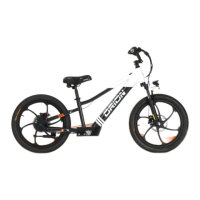3
CAUTION: For your safety you must carefully read this manual and follow its instructions.
Your electric balance bike may come with additional instruction sheets that cover features
unique to your bike. Please ensure that you read and become familiar with their contents and
retain them with this manual for future reference. Remember electric balance bikes, in most
areas, are subject to the same laws, rules, and regulations as motor vehicles.
Always wear a Certied helmet when riding your bike. Learn and follow local and state trac
use laws.
Any major service or adjustments on your bike not covered in this manual should be carried out
by an authorized Orion dealer. If you wish to make adjustments yourself, this manual contains
important tips on how to do it.
CAUTION: Any adjustments you make are entirely at your own risk. Do NOT use your bike for
freestyle and stunt riding, jumping or competitive events. Do not ride your bike when any part is
damaged or not working properly. You must, for your safety and the safety of other users,
consult an authorized Orion dealer for any questions on repairs or maintenance.
WARNING: Like all mechanical components, bicycles are susceptible to wear and high
stresses. Various materials and components respond dierently to wear and stress fatigue. As
your bicycle ages, it is advisable to conduct more frequent inspections for deformed, cracked,
bent, or loose components. These conditions could result in sudden failure, posing a risk of
injury to the rider. If any part is cracked or broken, DO NOT RIDE until repairs have been made.
BEFORE RIDING
1. WARNING-ON AND OFF -ROAD CONDITIONS: The condition of the riding surface
signicantly impacts your safety. When the surface is wet or contains sand, leaves, small
rocks, or other loose debris, exercise extra caution. Gradually reduce the speed of the bicycle
and ride with heightened awareness. It will require a longer time and greater distance to
come to a stop. Apply the brakes earlier and with gentler force. Always initiate the rear brake
rst, allowing sucient time and distance for it to take eect. Subsequently, cautiously
engage the front brake to maintain control of the bicycle. Hasty application of the front brake
may result in a front pitch-over or a fall. Practice proper brake usage under controlled
conditions until you become adept at braking eectively under all road conditions.
2. NOTICE: State and federal regulations mandate the installation of a complete set of
reectors on bicycles. Certain state and local laws may additionally stipulate the inclusion of
a warning device, such as a horn or bell, and in most cases, a light. It is crucial to note that
the manufacturer and many legal authorities neither approve nor encourage riding at night.
Vision is signicantly limited during dawn, dusk, and nighttime for bike riders, motorists, and
bystanders. If riding at night is unavoidable, exercise extra precautions by using front and
rear lights, wearing ashers on your arms, donning light-colored clothing, and planning your
route to traverse well-lit areas while avoiding heavy trac zones.
3. NOTE: It is essential to always wear protective shoes while riding a bicycle and avoid loose-
PRE-RIDE SAFETY

